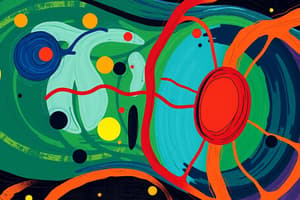Podcast
Questions and Answers
What is the correct ordering of muscle units from the smallest to largest?
What is the correct ordering of muscle units from the smallest to largest?
- sarcomere -> myofibril -> muscle fiber -> skeletal muscle
- myofibril -> sarcomere -> muscle fiber -> skeletal muscle (correct)
- muscle fiber -> myofibril -> sarcomere -> skeletal muscle
- skeletal muscle -> muscle fiber -> sarcomere -> myofibril
Which regions of the sarcomere change in size during contraction?
Which regions of the sarcomere change in size during contraction?
- I band, H zone
- Z line, A band
- M band, H zone
- A band, I band (correct)
In the context of muscle units, what does the Z line represent?
In the context of muscle units, what does the Z line represent?
- A boundary that defines the end of a sarcomere (correct)
- A region with high protein concentration
- The center of the sarcomere
- The part where actin and myosin filaments overlap
Which component of a skeletal muscle is responsible for generating force during contraction?
Which component of a skeletal muscle is responsible for generating force during contraction?
What happens to the A band in the sarcomere during contraction?
What happens to the A band in the sarcomere during contraction?
Which structure is primarily responsible for the striated appearance of skeletal muscle fibers?
Which structure is primarily responsible for the striated appearance of skeletal muscle fibers?
What is the function of the H zone in a sarcomere?
What is the function of the H zone in a sarcomere?
During muscle contraction, which structure pulls the Z lines closer together?
During muscle contraction, which structure pulls the Z lines closer together?
What is the primary function of sarcomeres within muscle fibers?
What is the primary function of sarcomeres within muscle fibers?
Which component of a muscle fiber contains the contractile proteins actin and myosin?
Which component of a muscle fiber contains the contractile proteins actin and myosin?
Flashcards are hidden until you start studying
Study Notes
Cell Signaling
- cAMP acts as a 2nd messenger, which is a cytoplasmic signal molecule involved in signal transduction pathways.
- 1st messenger: signal molecule (ligand) binds to receptor to initiate cellular response.
- Examples of 2nd messengers: cAMP, Ca2+, phosphatidylinositol triphosphate, nitric oxide.
Signal Transduction Pathways
- PKA (protein kinase A) is inactive when bound to glycogen.
- When cAMP binds to PKA, it becomes active and stimulates glycogen breakdown.
- Phosphatase removes Pi (inorganic phosphate) to inactivate the protein.
- GTPase (G-protein) is active when bound to GTP and inactive when bound to GDP.
Cell Signaling Types
- Juxtacrine signaling requires physical contact between the signaling cell and receiving cell.
- Autocrine signaling: a cell responds to its own signal molecules.
- Paracrine signaling: a cell responds to signal molecules from nearby cells.
- Endocrine signaling: a cell responds to signal molecules from distant cells.
Caffeine
- Caffeine is a competitive inhibitor of adenosine.
- It does not activate drowsiness.
Nervous System
Brain Anatomy
- Cerebrum: largest part of the brain.
- Pons and cerebellum: structures in the brainstem.
- Neural tube: precursor of the brain that develops over time.
- Structures to know: cerebrum, glands, midbrain, pons, cerebellum, medulla, spinal cord.
Central and Peripheral Nervous Systems
- CNS (Central Nervous System): brain and spinal cord.
- PNS (Peripheral Nervous System): nerves outside the brain and spinal cord.
- Neuron: a single electrically excitable cell with long axons.
- Afferent neurons: transmit signals from sensory receptors to the CNS.
- Efferent neurons: transmit signals from the CNS to muscles or glands.
Neuron Structure
- Dendrites: receive input from other neurons.
- Cell Body: contains organelles.
- Axon Hillock: at the cell body/axon border.
- Axon: conducts the signal.
- Synapse: connects the axon terminus to dendrites of the postsynaptic neuron.
Glial Cells
- Support and protect neurons.
- Types of glial cells: astrocytes, oligodendrocytes, Schwann cells.
- Astrocytes: link axons to capillaries (blood flow).
- Oligodendrocytes: found in CNS axons.
- Schwann cells: found in PNS axons.
Neuronal Signaling
- Voltage-gated channels: Na+ and K+ channels.
- Resting potential: -60 mV.
- Threshold: -50 mV.
- Action potential: +50 mV.
- Sodium/potassium pump: reestablishes the Na+ and K+ gradients.
Muscle Structure
- Skeletal muscle: made up of many muscle fibers.
- Muscle fiber: contains many myofibrils.
- Myofibril: contains many sarcomeres.
- Sarcomere: unit of contraction apparatus.
Muscle Contraction
- Sliding filament model: actin and myosin filaments slide past each other.
- Actin filaments: 2 strings of pearl beads wrapping around each other.
- Myosin filaments: 2 ropes wrapping around each other.
- Ca2+ increase in sarcoplasm triggers muscle contraction.
- ATP hydrolysis is required for contraction.
Studying That Suits You
Use AI to generate personalized quizzes and flashcards to suit your learning preferences.




